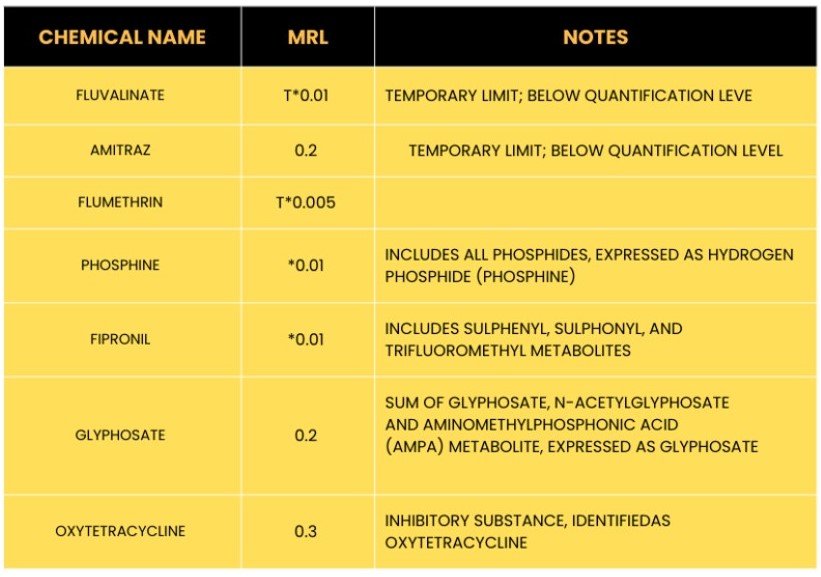Maximum Residue Limits
This information is to inform beekeepers of domestic and international laboratories who provide services for maximum residue limit (MRL)testing.
MRL testing verifies if contaminants or impurities remain on produce which can occur through several pathways including naturally, industrial or agricultural activities, fungus, heavy metals, chemical applications and can identify those that threaten human health, safety of producers and the entire supply chain.
Maximum Residue Limit (MRL)
What is an MRL in beekeeping?
MRL stands for Maximum Residue Limit, which in beekeeping context, is a number that represents the highest level of chemical residue allowed in honey, beeswax, or other bee products to ensure they are safe for consumption. It is a legal requirement that any honey sold for human consumption is below all prescribed MRL’s.
How do residues get into honey or bee products?
Residues can enter honey and bee products through beekeeping practices, from the environment the bees are operating in or through the nectar and pollen the bees are collecting.
How are MRLs for bee products enforced?
MRLs are monitored through a range of systems, from the national residue survey to individual state and territory testing and business level quality assurance audits. It is the responsibility that all direct to customer honey producers (recreational or commercial beekeepers) must ensure their products do not exceed safe residue levels, or face recalls or penalties.
How can beekeepers reduce pesticide exposure?
Good beekeeping practices can reduce the risk of exceeding MRLs this includes:
- Implement a quality assurance program like BQUAL to ensure traceability and record keeping
- Adhere to any permit or label recommendations when using any hive treatments for controlling pest or diseases
- Communicate with nearby growers to minimise the risk of spray drift or contamination. Register your hives on the BeeConnected app to facilitate good communications
- Regularly test honey if there is any risk that the honey or bee products could exceed MRLs
Australian Legislated MRLs
Australian Legislated Maximum Residue Limit (MRL)

For further details visit Food Standards Australia & New Zealand
Lab Details |
Test Code & Sample Size |
MRL Test Description |
Cost Estimate |
Turnaround |
| Symbio Labs
Eight Mile Plains www.symbiolabs.com.au |
CR050
200g each |
Multi-residue test (not inc Flumethrin or tau-fluvinate) $321.44
Flumethrin only $386.92 + Admin fees $40 |
from $380 + GST (multiresidue) or
from $440 + GST (flumethrin only) |
5-10 days |
| Amal Analytical
Huntingdale www.amalanalytical.com.au jeremy@amalanalytical.com.au (03) 95 444 111 |
RS1, RS2, CRS, GLY
50-100g |
RS1 – Multiresidue screen 1 GCMS (125+ analytes), RS2 – Multiresidue screen 2 LCMS (125+analytes), CRS – combined RS1+RS2 (250+ analytes), GLY – Glyphosate screen | $225 – 350 p/test approx. | 3-5 business days standard |
| Leeder Analytical
Fairfield www.leeder-analytical.com enquiries@leeder-analytical.com |
100g | 1. Pesticides-Amitraz, Chlorfenvinphos,Coumaphos,Cymiazole,Flumethrin, tau-Fluvalinate, malathion inc malaoxon | 1. $320.00 +GST
2. $380.00 + GST $60/per batch minimum 3 samples per batch |
10 working days |
| 100g | 2. Acrinathrin, Amitraz, Bromopropylate, chlorfenvinphos, Coumaphos,Cymiazole,Flumethrin, tau-Fluvalinate, malathion inc malaoxon,Tetradifon | |||
| Freshmark
Sydney, Brisbane, VIC, WA www.freshmark.com.au nswchamber@freshmark.com.au |
C6M
100g |
Mega Residue | $210.60 | 3 days |
| Flumethrin
100g |
Flumethrin only | $465 + GST | 3 days | |
| Tetamus
Vietnam www.tentamus.vn hello.vn@tentamus.com |
P0008
200g |
Pesticides-Amitraz, Chlorfenvinphos,Coumaphos,Cymiazole,Flumethrin, tau-Fluvalinate, malathion inc malaoxon | $227.00 | 5-7 working days |
| P0009
200g |
Acrinathrin, Amitraz, Bromopropylate, chlorfenvinphos, Coumaphos,Cymiazole,Flumethrin, tau-Fluvalinate, malathion inc malaoxon,Tetradifon | $314.00 | 5-7 working days | |
| Intertek
Germany ww.intertek.com analysis_aus@intertek.com |
101183
100g |
Bee treatment agents and Varroacides-3 by GC-MS/MS and LC-MS/MS: Amitraz (incl. metabolites), Chlorfenvinphos, Coumaphos, Cymiazole, Flumethrin, tau-Fluvalinate, Malathion (incl. Malaoxon) |
from $260+GST + freight to Bremen (from Adelaide) which is charged at additional cost. | 5 working days from receipt of sample in Bremen. |
| 101184
100g |
Bee treatment agents and Varroacides-4 by GC-MS/MS and LC-MS/MS: Acrinathrin, Amitraz (incl. metabolites), Bromopropylate (incl. 4,4′-DBBP), Chlorfenvinphos, Coumaphos, Cymiazole, DEET, flumethrin, tau-Fluvalinate, Malathion (incl. Malaoxon), Tetradifon | $305+GST + freight to Bremen (from Adelaide) which is charged at additional cost. | 5 working days from receipt of sample in Bremen. |
|
| Hills Laboratories
New Zealand www.hill-labs.co.nz +64 7 858 2000 |
50-60g | Bee treatment agents and Varroacides: Flumethrin testing bundled with tau-Fluvalinate | NZ$245 (no GST will be applied for samples from Australia) + additional handling fee of NZ$150 will be charged per batch. | 10-15 days |
| Awanui ScientificNew Zealand
awanuiscientific.co.nz scientificsales@awanuigroup.o.nz |
100g | Amitraz (incl. metabolites) | Est NZ$110 | 10 days |


